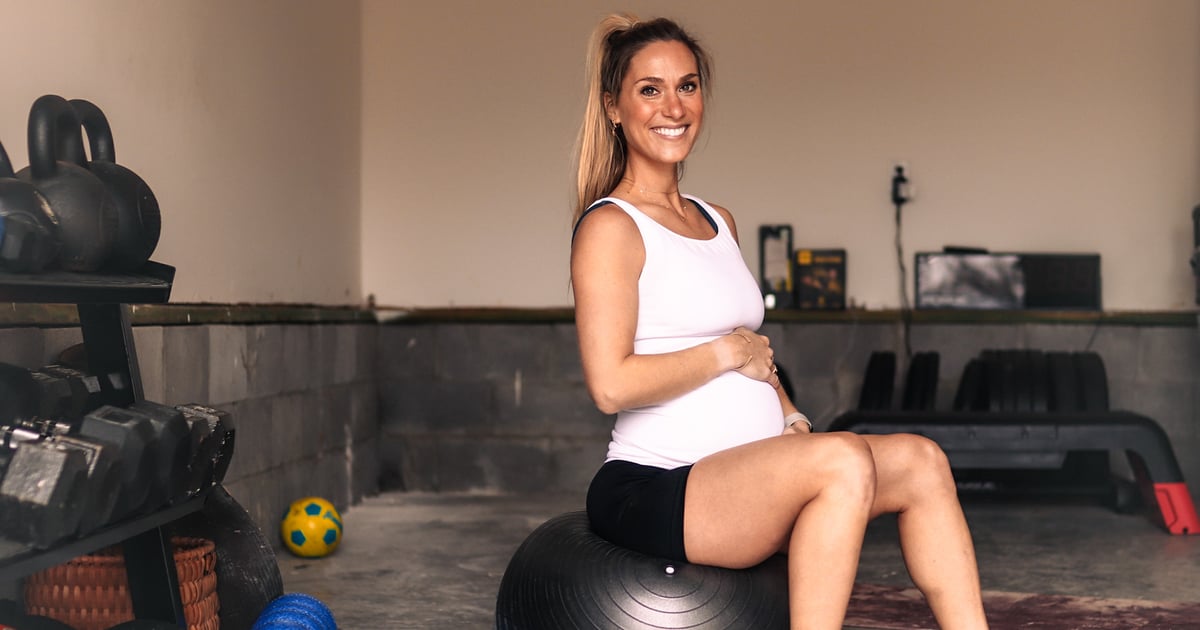“I wanted to give birth on all fours – and my training program helped make it happen”

When Macy Pruett, 31, found out she was pregnant with her second child, one of the first things she did was create an exercise plan — perhaps a natural response for a certified personal trainer. Pruett had a few regrets about her first birth experience and some ideas about what she wanted to do differently this time, starting with her prenatal fitness regimen.
“My workouts weren’t necessarily for pregnancy and motherhood — and when I say motherhood, I include pregnancy, labor and delivery, and postpartum,” Pruett tells POPSUGAR of her first experience with prenatal exercise. This time, Pruett wanted to use what she knew about how her body reacted to pregnancy and childbirth to help determine her fitness goals. But she also wanted to create a whole training plan around the birth position she hoped to give birth in: on all fours.
“We grow up giving birth to women screaming and laying on their backs with their legs spread, telling the nurses to push and push,” says Pruett. Many people deliver safely and happily on their backs — but from her research, Pruett knew it wasn’t the only position. She had delivered her firstborn on her side, and she had also learned about some of the potential benefits of giving birth on all fours, also known as the hands-and-knees position. For example, it’s thought to relieve pressure on your back, aid in baby rotation during labor and give your healthcare team a clear picture of what’s happening, according to Penn Medicine. Pruett felt that this position could be the ticket to a less painful delivery, with a lower risk of vaginal tears.
@fittestcore You CAN feel strong and confident in working positions! Join my prenatal program Training For Motherhood – link in bio 🤰🏼💪🏼 #trainingformotherhood #morewithfittestcore #prenatalfitness #laborpositions #birthprep #fitpregnancy #fitpregnancyjourney #pregnant🤰
♬ Daydreaming – Gentle State
But the all fours position can require strength and flexibility in different parts of the body, so Pruett wanted to make sure her workout routine was designed to help her perform in the position. So she incorporated a lot of bird dog variations into her workouts, adding resistance and Pilates balls to strengthen her core and pelvic floor. She also did exercises designed to help her body deliver back to the lateral position, just in case it felt best when the time came.
In addition, Pruett performed movements that would mimic movements she should do after giving birth. She made sure to do Romanian deadlifts, for example, because she thought it would help her lift a heavy baby carrier off the floor or a chair. She wrote the whole experience on TikTok. What became her “training for motherhood” program began to garner more and more attention, with videos racking up thousands—and as many as five million—views.
When it came time to give birth, Pruett said her workouts paid off. She started on her side, but she felt like she had “back labor,” which refers to lower back pain that can occur due to the position of the baby in the pelvis during labor. “I was working my back and I felt the pain in my tailbone,” she tells POPSUGAR. “It almost felt like my birth canal was closed off, if that makes sense.”
So she got down on all fours. “It relieved the pain to a degree. When I turned over on all fours, that felt like the most open position, which I knew from my training, which meant my pelvis literally opened up to make way for my son to get down to go,” says Pruett.
Pruett was born without medication and says she could feel her baby move through her. “I could kind of feel and track where he was and his descent through the birth canal,” she explains.
Feeling her baby allowed her to trust herself — and advocate for herself during labor. “There was a point where [the nurse] was instructed. . . to check how wide I was,” says Pruett. The nurse asked Pruett to lie on her back, but Pruett said no. I would sit on him and of course that would slow down the process. She said to me several times, “I want you to turn on your back so I can check on you.” And finally I just said, ‘No, I can’t. I will stay here.’ And probably 10 seconds later his head popped out.”
Looking back on her birth experience, Pruett says she is extremely proud of herself.
“Often unmedicated births, what [may] lead to switching positions and choosing your position are not always supported. It wasn’t really with my firstborn. And so, going into this birthing experience, my husband and I learned something like, ‘This is my birth and we get to advocate for ourselves,’” she says.
While Pruett says her nurse was incredibly supportive, it was the nurse’s first unmedicated birth and she wasn’t used to seeing the birthing position on all fours. “[Doctors and nurses are] so trained and they know what they learned and everything, but you know your body and what feels best. So that would be my advice to all new moms: advocate for yourself. Do what you have to do, because this is your birth,” says Pruett.
Six weeks postpartum, Pruett says she feels much stronger than when she gave birth to her first child. “I was also very active during my first pregnancy, but the recovery took a little longer, a little slower. I bled longer and it took a while for my core to connect.” This time, “I felt strong in the hospital right after giving birth,” says Pruett. While she didn’t work out right away, she believes that deliberately training her body to give birth in a specific position and for the movements she would do postpartum made all the difference. “It’s crazy how much I already feel connected to my core again, and my pelvic floor feels super strong,” she says.
@fittestcore Training For Motherhood: A Prenatal Training Program 🤰🏼💪🏼 Click the link in my bio for more info! #trainingformotherhood #prenatalfitness #pregnant #pregnancytiktok #pregnanttiktok #fitpregnancy #fitpregnancyjourney #fitpregnant #fitpregnantmama #morewithfittestcore #pregnant🤰
When she posted about her training journey on TikTok, Pruett kept getting asked why she felt the need to “train” for her experience in the first place. She read many variations of comments such as, “Women have literally been giving birth for billions of years. You don’t have to train for it.”
“While that is true, [training] helps so much,” says Pruett. “And so that’s kind of where I’d end up with. Should we do this? No. But does it help? Absolutely,” no matter what type of birth you choose, she says.
“If you’re up for it and following a program you trust, or trust yourself with training, I recommend 11 out of 10.” If you’re anticipating and interested in a training program, visit Pruett’s website to try her “Training For Motherhood” series, or search Google for a prenatal program near you. But all bodies and pregnancies are different, so be sure to go through each exercise program with your ob-gyn before you begin.
Image Source: Courtesy of Jenn Cutliffe
Stay connected with us on social media platform for instant update click here to join our Facebook











